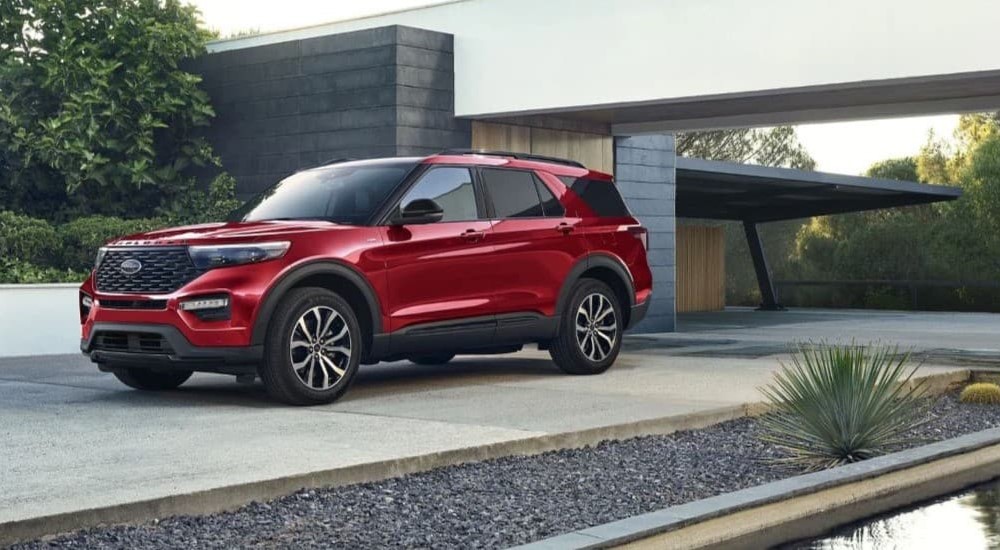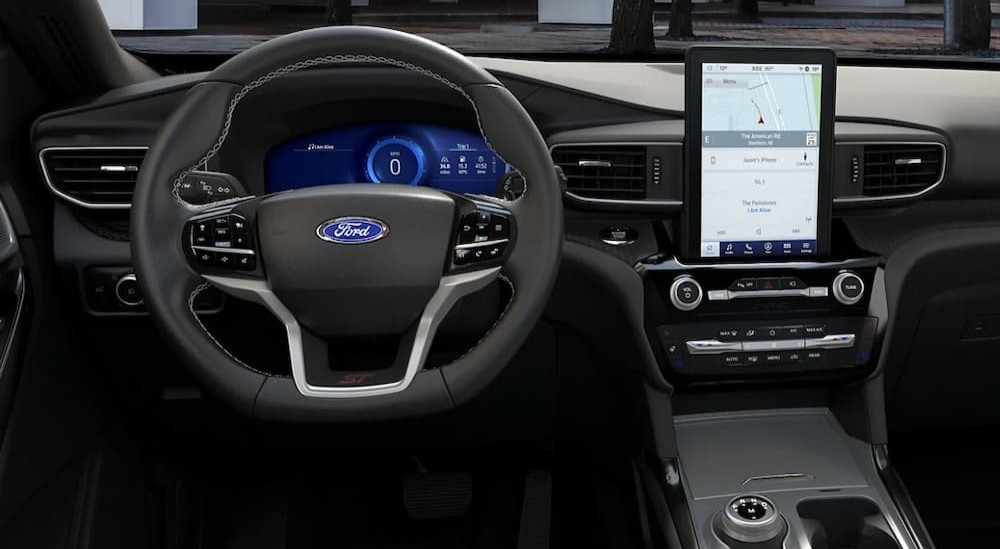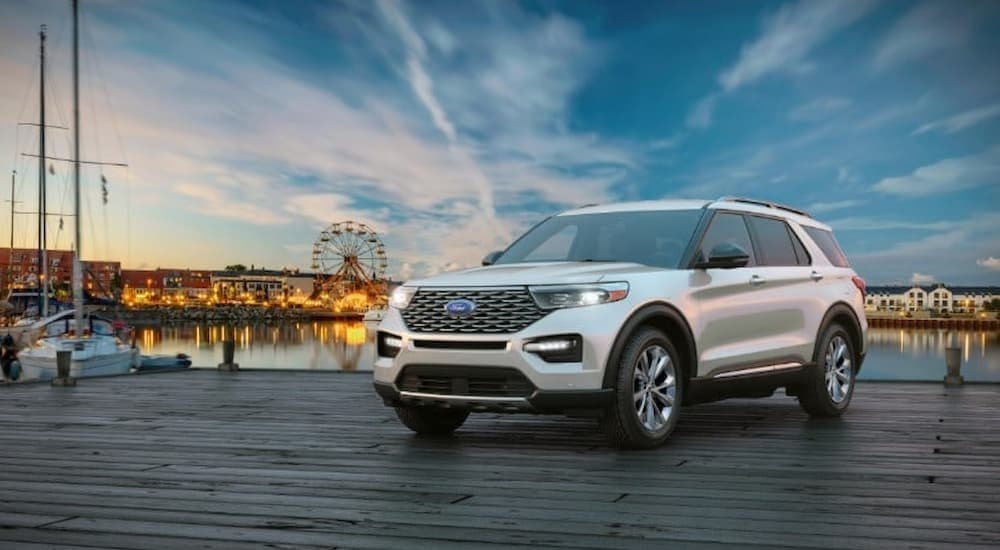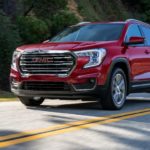They say change is the only constant, and that’s certainly true in the auto industry. From hybrid and all-electric models to self-driving vehicles, widespread automation, and new specialty models, there can be a lot to keep up with when you’re in the market for your next vehicle. One undeniable trend would have to be the advent of the SUV. While this segment accounted for just 32.6% of the market in 2013, that number has now grown to 47.4%. To put it another way, nowadays, about half of the new vehicles sold in any given year are SUVs.
This growth has largely been spurred by the introduction of new crossover SUVs—versatile vehicles that combine the cargo space and ride height of the traditional body-on-frame SUV with the unibody construction popular among sedans. This approach has enabled a new era of comfort and practicality without sacrificing the performance or utility that’s made SUVs so popular. Three-row crossover SUVs like the 2025 Ford Explorer represent a real sweet spot within the segment for a few simple reasons.
Between their passenger and cargo room, tech-laden interiors, luxury features, and wide ranges of powertrain options that allow for easy customization, midsize crossovers are at the forefront of a number of current industry trends. Let’s take a detailed look at some of these trends and see how SUVs like the 2025 Ford Explorer are setting the stage for the segment’s future…
Bigger Is Better
The SUV segment is on the rise as a whole, with a projected annual growth rate of 6.6%. Currently valued at $885.8 billion, SUVs could easily grow into a $1.2 trillion business by 2025. This is good news for the segment, but as you dive into the numbers, it’s the midsize models that seem to be one of the biggest drivers of growth. Compact SUVs have certainly had their moment in the sun, but as the segment (and the customer base) continues to mature and evolve, it’s roomier midsize SUVs that seem to hold the most appeal.
This trend isn’t limited to the SUV segment; all across the industry, drivers seem to be gravitating toward larger vehicles. According to a study by the University of Michigan’s Transportation Research Institute (UMTRI), the average vehicle grew by 12% in length and 17% in width over the last decade. This evolution makes a lot of sense when you stop to think about it, especially from a consumer perspective: as smaller crossover SUVs began to take hold in the early 2010s, a new generation of drivers ditched the entry-level sedans of yesteryear for new compact and subcompact SUVs.
These drivers are now growing up and are looking for roomier alternatives that can accommodate their growing families, their weekend adventure gear, and a week’s worth of groceries. Once upon a time, that might have meant swallowing your pride and joining the minivan set, but today’s midsize SUVs provide a more stylish, practical alternative that gives drivers all the space they need without sacrificing the ride height and comfort to which they’ve become accustomed.
The 2025 Ford Explorer certainly encapsulated this trend. Ford has steadily grown its midsize SUV over the last decade, expanding the Explorer’s cargo room to fit the needs of a changing customer base. Back in the Explorer’s fourth generation (2006 to 2010), it was on the cozier side of the spectrum, with 13.6 cu.ft. of available storage behind the third row; that number increased to 43.9 cu.ft. with the third row folded, but the SUV still lagged behind some of its competitors.
Ford has addressed that issue in the subsequent generations, subtly upsizing the Explorer’s cabin without a noticeable impact on ride quality or style. Today’s sixth-generation Explorer is a marked improvement over the fourth-gen model, boasting 18.2 cu.ft. of rear cargo space and 47.9 cu.ft. when the third row is folded; that’s enough room to accommodate as many as 31 pieces of carry-on luggage—an impressive figure that would allow the Explorer to pull double duty as an airport shuttle if you were so inclined.

Turbo Power & Efficiency
Some trends can be hard to predict, but others are pretty easy to see coming. Since 1975, the US government has required all automakers to meet Corporate Average Fuel Economy (CAFE) standards as a means of reducing fossil fuel consumption and dependence on foreign oil. So far, it’s worked, reducing oil consumption by an estimated 25% and saving nearly five million barrels of oil per day.
These standards don’t target individual models but rather a brand’s entire fleet, so automakers will game this system by introducing ultra-efficient vehicles that make up for some of the company’s more gas-guzzling models—but it’s all above board so long as the overall lineup hits a certain fuel economy rating. That rating has been on a steady rise since the measure was first introduced, climbing from 27.5 MPG in 1985 to 44.2 MPG for the 2024 model year.
That number will continue to climb in the coming years, with a goal of 49 MPG by 2026 and 58 MPG by 2032. Hybrid, plug-in hybrid, and all-electric vehicles have been a big part of the CAFE formula for automakers over the last decade, and while that trend certainly looks like it’ll continue, gas-powered vehicles have also seen a steady increase in overall fuel economy. This has largely been accomplished through an increased reliance on forced induction, with today’s turbocharged engines enabling a new era of efficiency.
Take the 2025 Ford Explorer, for instance. Every model comes with a turbocharged engine, whether it be the 2.3-liter turbocharged four-cylinder on the Active, ST-Line, or Platinum trims or the twin-turbo 3.0-liter V6 found on the performance-minded ST. When optioned as a rear-wheel drive model, the 2.3-liter inline-four boasts an impressive 21 MPG in the city and 28 MPG on the highway. The twin-turbo 3.0-liter V6 lags a bit behind at 18 MPG in the city and 26 MPG on the highway, but it’s still a good showing when you consider the three-row SUV’s size.
Of course, these sorts of fuel economy figures wouldn’t be worth a hill of beans if the Explorer was lacking in power, but that’s the beauty of the turbocharged approach: pumping more air into the engine allows vehicles like the 2025 Explorer to retain their brawny reputation without sacrificing fuel economy, as evidenced by the 400-hp ST trim. The 2.3-liter inline-four is no slouch either, with 300 hp and 310 lb-ft of torque at your disposal every time you step on the gas.
While Ford did briefly offer a hybrid version of the Explorer, that model was just recently discontinued. The Blue Oval just invested $22 billion in a company-wide push toward electrification, so we wouldn’t be surprised to see another hybrid—or even all-electric—version of the Explorer hit the market in the coming years as part of Ford’s pledge to shift half its sales volume to EVs by 2030.

Tech-Forward Design
An increased focus on technology has been a driving trend in the auto industry over the past few decades, and that doesn’t look to be changing anytime soon. From hardware like head-up displays, digital rearview mirrors, and surround-view camera systems to the software used to control features like the infotainment system, adaptive cruise control, lane-keeping assist, and other advanced driver assistance systems (ADAS), drivers are now seeking out in-vehicle tech like never before.
According to a study from AutoTrader, 60% of millennials and 40% of boomers indicated they would switch brands and spend as much as an extra $2,200 to get access to the type of technology they’re looking for. Autonomous driving represents another alluring tech element for many drivers, with more than 70% of potential buyers indicating an interest in this cutting-edge tech. These trends don’t look to be slowing down anytime soon, and only time will tell what sort of impact the advent of artificial intelligence will have on the auto industry—so how are brands responding?
While drivers were once content to get by with nothing more than a digital clock and simple AM/FM radio, the infotainment displays found on most of today’s cars, trucks, and SUVs represent the new standard for in-vehicle technology. Just three years ago, the average infotainment display measured in at just around seven inches, but that number is now closer to ten. While bigger isn’t always necessarily better, the size of the infotainment display has become the industry’s newest arms race.
The 2025 Ford Explorer is a great example of the trend. Just last year, this SUV came standard with an 8.0-inch touchscreen, but that number has now grown to 13.2 inches across all four trims. Throw in a 12.3-inch digital gauge cluster, and it’s easy to see that Ford is all-in on modernization. Larger screens make for easier navigation and visibility, but the software these infotainment displays run on is just as important, if not more so. With that in mind, Ford has rolled out an entirely new infotainment software platform for 2025 dubbed Ford Digital Experience.
With endless customization potential, connected apps, and a built-in digital assistant, the Ford Digital Experience allows the Explorer to double as a mobile theater, home office, or gaming station. Passengers can stream content on the go or surf the web through the Vivaldi Browser app. The infotainment systems can even be used with a Bluetooth-connected keyboard or gaming controller, giving passengers access to Google Play’s wide selection of games, including a Ford-exclusive version of Asphalt Nitro 2.
But the infotainment system is just a small part of the Explorer’s tech-heavy cabin as this SUV also features eight USB ports, three 12-volt power outlets, and a twelve-speaker Bang & Olufsen stereo system. The Explorer is also offered with a long list of standard ADAS features from forward-collision warning and automated emergency braking to blind-spot monitoring, rear-cross-traffic alerts, lane-departure warning, and lane-keeping assist.
Looking Ahead With the Ford Explorer
It’s hard to tell what the future holds, especially in today’s rapidly evolving auto industry. Consumer tastes are changing at breakneck speed and often leaving brands to play catchup. The impact of electrification is certainly hard to ignore, but it’s not the only trend that’s shaping the market. Ford certainly seems to be staying ahead of the curve when it comes to navigating these changes, especially when it comes to the 2025 Explorer.
This midsize model is one of the longest-running SUVs on the market, but this legacy automaker has leveraged its hundred-plus years of experience to keep the three-row SUV fresh for more than three decades. From increasing cargo space and staying abreast of technological developments to integrating the latest and greatest in turbochargers for a surprisingly powerful and efficient range of engines, the 2025 Ford Explorer is a prime example of an SUV that’s managed to change with the times.




